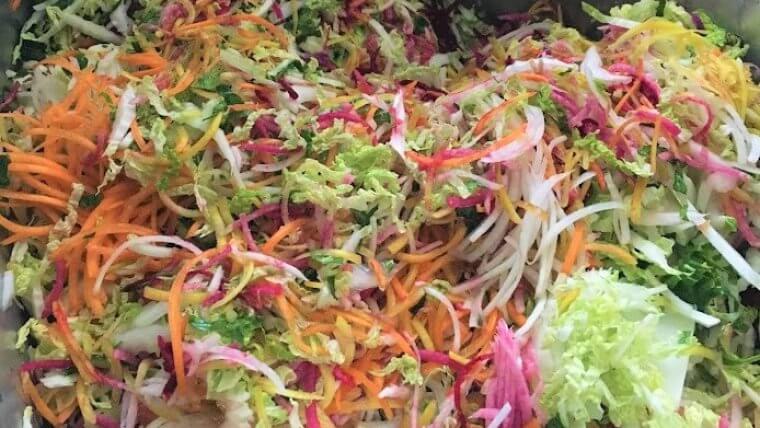
Ingredients
- 1 large napa cabbage
- 1-2 daikon radishes
- 1 onion
- 3-5 cloves garlic
- 2-3 carrots
- ½ bunch kale or Swiss chard
- 1 tablespoon fennel seed
- 1-2 teaspoon coriander seed
- Chiles, chopped (optional)
- Plenty of sea salt
- Additional root/cabbage vegetables (optional)
Directions
You’ll need a food processor and a fermentation crock if you want to follow this recipe exactly. If you don’t have a crock, you can adapt it to mason jars.
Clean, sanitize, and rinse your sink thoroughly. Plug the bottom. Use the shredder attachment on a food processor to shred all the vegetables except the greens. Shred into the food processor, emptying it into the sink whenever it gets full. Cut the greens into thin strips with a knife (about ¼ inch). Chop the chiles (optional) into the sink, too, unless you’re wary of the heat. We don’t make ours spicy, in order to ensure it’s palatable for the kids. Toss everything in the sink with enough salt that it tastes quite salty (use gloves if there are chiles in it). Toss the seeds in, too. The salt will pull liquid out of the vegetables, and you should let it “sweat” in the sink for 2-4 hours.
Stuff the vegetables into your vessel(s), and use a ladle to spoon all the vegetable liquid in on top of it. Stuff the shredded vegetables in as hard as you can and place something on top to keep them from floating. If they are not completely covered, add a bit of non-chlorinated water (use bottled water, or leave tap water out in a pan for a day or two ahead of time to let the chlorine off-gas). Seal the vessel, remembering that gases need to escape during the process, so if you’re using jars, unscrew the lids once or twice a day to vent the ferment.
You should keep it at a temp of 70°F or higher, so a spot in your home is probably fine. It should ferment for 3-5 days. Don’t bother checking before 3 days, but after that you should check once or twice a day. Deciding when it’s ready is a matter of taste, but generally speaking, a kimchi should have a bright and bubbly taste, not a real sour taste like sauerkraut, and the vegetables should still be somewhat crunchy. To stop the fermentation process, it needs to be put in the refrigerator (transferred into jars first, if necessary). It will be shelf-stable for at least 6 months if refrigerated. It will turn mushy if left unrefrigerated or allowed to ferment too long.

